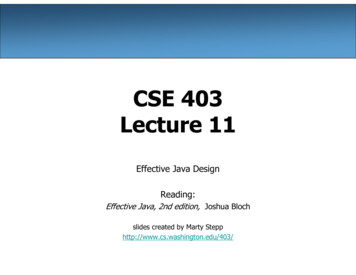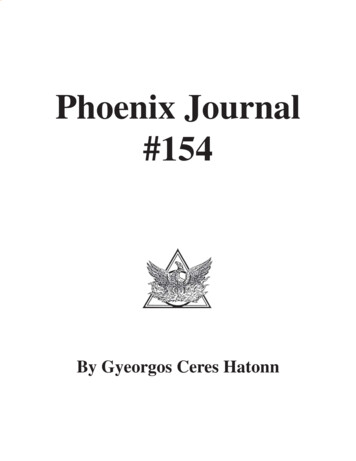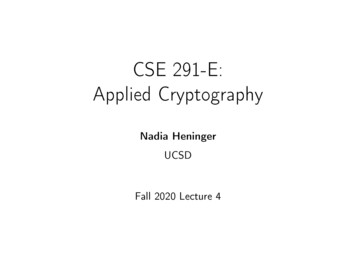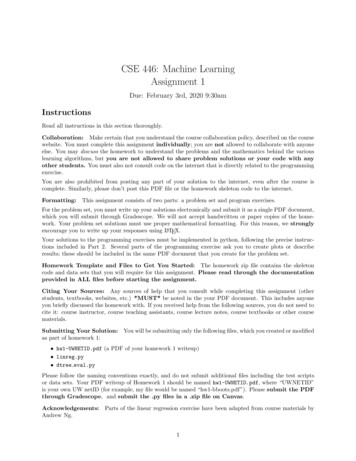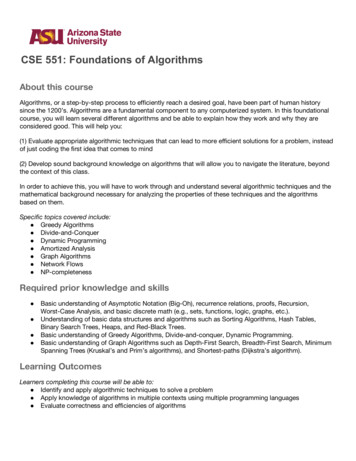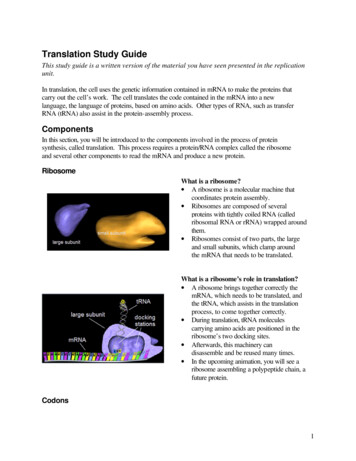
Transcription
CSE 154LECTURE 18: THE DOCUMENT OBJECT MODEL (DOM);UNOBTRUSIVE JAVASCRIPT
Document Object Model (DOM)a set of JavaScript objects that represent each element on the page each tag in a page corresponds to a JavaScript DOM object JS code can talk to these objects to examine elements' state e.g. see whether a box is checked we can change state e.g. insert some new text into a div we can change styles e.g. make a paragraph red
DOM element objects access/modify the attributesof a DOM objectwith objectName.attributeName most DOM object attributeshave the same names as thecorresponding HTMLattribute img tag's src property a tag's href property
Accessing an element: document.getElementByIdvar name document.getElementById("id");JS img id "icon01" src "images/octopus.jpg" alt "an animal" / button onclick "changeImage();" Click me! /button HTMLfunction changeImage() {var octopusImage document.getElementById("icon01");octopusImage.src "images/kitty.gif";}JSoutput document.getElementById returns the DOM object for an element with a given id
DOM object properties div id "main" class "foo bar" p See our a href "sale.html" id "saleslink" Sales /a today! /p img id "icon" src "images/borat.jpg" alt "Borat" / /div var mainDiv document.getElementById("main");var icon document.getElementById("icon");var theLink meclassNameinnerHTMLsrchrefDescriptionelement's HTML tagCSS classes of elementcontent in elementURL target of an imageURL target of a linkExamplemainDiv.tagName is "DIV"mainDiv.className is "foo bar"mainDiv.innerHTML is "\n p See our a hr.icon.src is "images/borat.jpg"theLink.href is "sale.html"HTMLJS
DOM properties for form controls input id "sid" type "text" size "7" maxlength "7" / input id "frosh" type "checkbox" checked "checked" / Freshman?HTMLvar sid document.getElementById("sid");var frosh aluecheckeddisabledreadOnlyDescriptionthe text/value chosen by the userwhether a box is checkedwhether a control is disabled (boolean)whether a text box is read-onlyExamplesid.value could be "1234567"frosh.checked is truefrosh.disabled is falsesid.readOnly is false
More about form controls select id "captain" option value "kirk" James T. Kirk /option option value "picard" Jean-Luc Picard /option option value "cisco" Benjamin Cisco /option /select label input id "trekkie" type "checkbox" / I'm a Trekkie /label HTMLoutput when talking to a text box or select, you usually want its value when talking to a checkbox or radio button, you probably want to know ifit's checked (true/false)
The innerHTML property button onclick "addText();" Click me! /button span id "output" Hello /span HTMLfunction addText() {var span document.getElementById("output");span.innerHTML " bro";}JSoutput can change the text inside most elements by setting the innerHTML property
Abuse of innerHTML// bad style!var paragraph HTML " p text and a href \"page.html\" link /a ";JS innerHTML can inject arbitrary HTML content into the page however, this is prone to bugs and errors and is considered poor style we forbid using innerHTML to inject HTML tags; inject plain text only (later, we'll see a better way to inject content with HTML tags in it)
Adjusting styles with the DOMobjectName.style.propertyName "value";JS button onclick "colorIt();" Click me! /button span id "fancytext" Don't forget your homework! /span HTMLfunction colorIt() {var text lor "#ff5500";text.style.fontSize "40pt";}JSoutputPropertystyleDescriptionlets you set any CSS style property for an element same properties as in CSS, but with camelCasedNames, not names-with-underscores examples: backgroundColor, borderLeftWidth, fontFamily
Common DOM styling errors many students forget to write .style when setting stylesvar clickMe document.getElementById("clickme");clickMe.color "red";clickMe.style.color "red";JS style properties are capitalized likeThis, not like-thisclickMe.style.font-size "14pt";clickMe.style.fontSize "14pt";JS style properties must be set as strings, often with units at the endclickMe.style.width 200;clickMe.style.width "200px";clickMe.style.padding "0.5em"; write exactly the value you would have written in the CSS, but in quotesJS
Unobtrusive JavaScript JavaScript event code seen previously was obtrusive, in the HTML; this is bad style now we'll see how to write unobtrusive JavaScript code HTML with no JavaScript code inside the tags uses the JS DOM to attach and execute all JavaScript event handlers allows separation of web site into 3 major categories: content (HTML) - what is it? presentation (CSS) - how does it look? behavior (JavaScript) - how does it respond to user interaction?
Obtrusive event handlers (bad) button onclick "okayClick();" OK /button // called when OK button is clickedfunction okayClick() {alert("booyah");}HTMLJSoutput this is bad style (HTML is cluttered with JS code) goal: remove all JavaScript code from the HTML body
Attaching an event handler in JavaScript codeobjectName.onevent function; button id "ok" OK /button var okButton document.getElementById("ok");okButton.onclick okayClick;JSHTMLJS it is legal to attach event handlers to elements' DOM objects in your JavaScript code notice that you do not put parentheses after the function's name this is better style than attaching them in the HTML
When does my code run? html head script src "myfile.js" type "text/javascript" /script /head body . /body /html HTMLvar x 3;function f(n) { return n 1; }function g(n) { return n - 1; }x f(x);JS your file's JS code runs the moment the browser loads the script tag any variables are declared immediately any functions are declared but not called, unless your global code explicitly callsthem at this point in time, the browser has not yet read your page's body none of the DOM objects for tags on the page have been created yet
A failed attempt at being unobtrusive html head script src "myfile.js" type "text/javascript" /script /head body div button id "ok" OK /button /div HTMLvar ok document.getElementById("ok");ok.onclick okayClick;// error: null problem: global JS code runs the moment the script is loaded script in head is processed before page's body has loaded no elements are available yet or can be accessed yet via the DOM we need a way to attach the handler after the page has loaded.JS
The window.onload eventfunction functionName() {// code to initialize the page.}// run this function once the page has finished loadingwindow.onload functionName; there is a global event called window.onload event that occurs at themoment the page body is done being loaded if you attach a function as a handler for window.onload, it will run at thattime
An unobtrusive event handler button id "ok" OK /button !-- (1) -- HTML// called when page loads; sets up event handlersfunction pageLoad() {var ok document.getElementById("ok");// (3)ok.onclick okayClick;}function okayClick() {alert("booyah");}// (4)window.onload pageLoad;// (2)JSoutput
Common unobtrusive JS errors event names are all lowercase, not capitalized like most variableswindow.onLoad pageLoad;window.onload pageLoad; you shouldn't write () when attaching the handler(if you do, it calls the function immediately, rather than setting it up to be called later)ok.onclick okayClick();ok.onclick okayClick; our JSLint checker will catch this mistake related: can't directly call functions like alert; must enclose in your own functionok.onclick alert("booyah");ok.onclick okayClick;function okayClick() { alert("booyah"); }
Anonymous functionsfunction(parameters) {statements;} JavaScript allows you to declare anonymous functions quickly creates a function without giving it a name can be stored as a variable, attached as an event handler, etc.JS
Anonymous function examplewindow.onload function() {var ok document.getElementById("ok");ok.onclick okayClick;};function okayClick() {alert("booyah");}JSoutput or the following is also legal (though harder to read and bad style):window.onload function() {document.getElementById("ok").onclick function() {alert("booyah");};};
Unobtrusive stylingfunction okayClick() {this.style.color "red";this.className "highlighted";}.highlighted { color: red; } well-written JavaScript code should contain as little CSS as possible use JS to set CSS classes/IDs on elements define the styles of those classes/IDs in your CSS fileJSCSS
The danger of global variablesvar count 0;function incr(n) {count n;}function reset() {count 0;} globals can be bad; other code and other JS files cansee and modify them How many global symbols are introduced by theabove code?incr(4);incr(2);console.log(count);JS 3 global symbols: count, incr, and reset
Enclosing code in a functionfunction everything() {var count 0;function incr(n) {count n;}function reset() {count );// call the function to run the code the above example moves allthe code into a function;variables and functionsdeclared inside anotherfunction are local to it, notglobal How many global symbols areintroduced by the abovecode? 1 globalsymbol: everything (can weget it down to 0?)
The "module pattern"(function() {statements;})();JS wraps all of your file's code in an anonymous function that is declared andimmediately called 0 global symbols will be introduced! the variables and functions defined by your code cannot be messed with externally
Module pattern example(function() {var count 0;function incr(n) {count n;}function reset() {count 0;} How many global symbols are introduced by theabove code? 0 global symbolsincr(4);incr(2);console.log(count);})();JS
JavaScript "strict" mode"use strict";your code. writing "use strict"; at the very top of your JS file turns on strict syntax checking: shows an error if you try to assign to an undeclared variable stops you from overwriting key JS system libraries forbids some unsafe or error-prone language features You should always turn on strict mode for your code in this class!
a set of JavaScript objects that represent each element on the page each tag in a page corresponds to a JavaScript DOM object JS code can talk to these objects to examine elements' state e.g. see whether a box is checked we can change state e.g. insert some new text in
